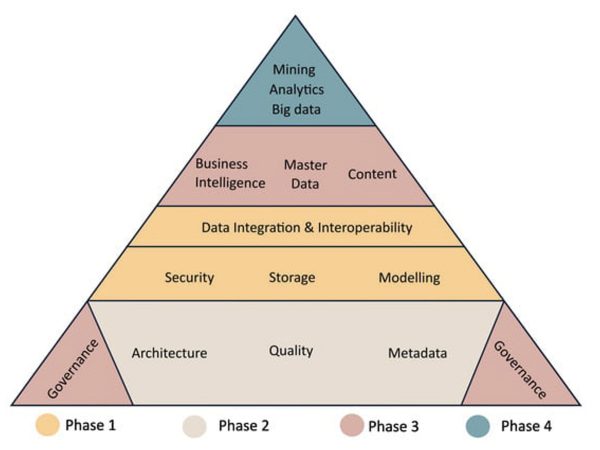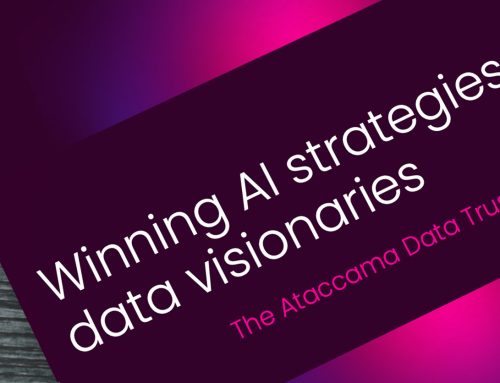Data is increasingly offering unprecedented opportunities for companies to capitalize on business opportunities and create new ones. Not only because there is more and more data that we can use, but also because the technological possibilities to use the data are increasing rapidly. The most recent example of this is of course the use of Artificial Intelligence (AI).
But even though companies are focusing on the many possibilities of data, we should not lose sight of the fact that we therefore need to organize more and more in order to be able to use that data in the right way. Therefore, the need for good management and governance of our data is becoming increasingly important at least as quickly. Organizations should consider whether the gap between the speed at which data capabilities are developing, are not growing out of sync with data management and governance? In this blog, we will discuss data management and data governance under the name data management.
In recent years we have seen organizations starting to pay attention to data management, but it came in waves, was reactive and fragmented.
Waves
What we observed is that data management applications arrived in waves. While we saw attention for master and reference data management from enterprises years ago, a few years ago we noticed that attention shift to data governance and most recently to data quality management and data lineage. On the one hand, this was due to a push from technology vendors, on the other hand due to attention from analysts. In addition, it was related to the issues that arose in organizations with the increasing possibilities of data.
Reactive
The large amount of data that has arisen in organizations created the need to arrive at a clear picture of this data. For example, an unambiguous view of customers of suppliers. This led to initiatives in the field of master data management. The same applies to data governance solutions for which the need started to exist in response to increasing legislation around the use of data. Today the quality of data has our attention as it is very basis for the outcome of all Artificial Intelligence efforts. Developments within organisations to date have been mainly reactive.
Fragmented
In addition to data management capabilities being introduced reactively, we also saw that this was often done in a fragmented manner. If we take master data management as an example again, typically this was initiated from one domain like the customer domain. The master data management solution was rarely looked at as a process and technology that could potentially add value in other domains. Governance would typically be driven by the then new Chief Data Officer role in the organization, but only thrives if it is adopted by all who use and depend on data in the organization.
The relevance of time
Today, many organizations have already taken the first steps in the field of data management, but there are also organizations that have yet to take the first serious steps. The question now arises how the above relates to the steps that organizations need to take in the area of data management in order to be able to use the opportunities off data correctly and fully? After all, it is realistic to think that the speed at which these opportunities continue to develop will continue to accelerate. All we need to do is see at how quickly the AI opportunity is developing, but also the challenges it puts before us.
Aiken pyramid
If you look at the Aiken pyramid, one could draw a comparison between IT and the proverbial iceberg in the ocean. Our focus is on the tip of the iceberg sticking out above the water which, in the case of the Aiken pyramid, corresponds to the tremendous opportunities that AI, big data, data analytics and data science have to offer our organizations.

However, you will immediately understand that the danger lies in the size and complexity of the part below the waterline, which in the Aiken pyramid is data management and the foundation of data governance. If you look over this, that could be a whole section of the iceberg your ship is running aground on!
Ask yourself the question how well you are positioned as an organization to respond to what’s below the waterline? How well are people, processes and technology prepared to get the most out of the possibilities of your data? Even more, how quickly can you develop in this area to stay on trend with all the possibilities that the data offers you. After all, when time and effort is invested in topics such as AI and data analysis, there is a chance that data management and governance efforts will get out of step, where it really shouldn’t!
A typical iceberg typically has 90% of its mass below the water, while only 10% of it is what we see above the water. So, if we want to grow 10% above the water, we will automatically see disproportionately more mass below the water. Now, think about this when it comes to leveraging the data opportunity for your organization. Can you, and are you willing to grow that underwater mass just as quickly as the bit that stick out of the water and that you see every day?
A key factor is technology. How easy or cumbersome is it to combine and integrate existing data management technology, and how easy and motivating is it for employees to master and adopt existing and possibly different technologies? Or, if you are still beginning or reconsidering your data management journey, what would give you the greatest flexibility and speed?
Think platform!
If you look at what we described above, and what we currently see as demand from the market, then the unified data management platform is the way forward. In a data management platform, all data management capabilities, including data governance, come together. But be aware, platform can quickly become an empty marketing term. Putting a ribbon around a set of tools, that were developed or purchased separately, does not necessarily make a unified data management platform.
A unified data management platform offers several advantages, illustrated using the People, Process, Technology (PPT) framework.
People
Offering a platform that provides a single user interface to its users offers several advantages. First and foremost, users will be pleased to understand they will have to learn to work in only one user interface. This will allow them to work with different data management capabilities without having to learn additional skills or the need to switch between applications. Additionaly, both IT and business users working in the same interface is likely to drive collaboration quicker. Faster learning and easier collaboration between users finally, will accelerate adoption and the extraction of value form the platform.
Process
From a data management process perspective, a unified data management platform offers users the advantage of being able to easily switch between activities and processes without the risk of losing work. In addition, with the integrated approach, they always have a clear picture of the quality of data and processes.
Technology
Not having to integrate different technologies may be one of the biggest advantages of a unified data management platform. Typically, many organizations may not have the skills nor the capacity to do the integration of different technologies. Having to do so, because point solutions were acquired, is a real risk of slowing down the implementation of an integrated approach to data management in your organization.
Ataccama ONE – the leading data management platform
This blog was written with the Ataccama Unified Data Management Platform in mind. What makes Ataccama ONE the leading data management platform is that it was built from the ground up as one technology, focused on the quality of your data, as input for your AI, data science and analytics activities. The Ataccama ONE platform feature several specific advantages:
- One of the unique benefits the unified platform provides is the superior user interface in which everything is seamlessly integrated. User can go easily from doing one activity to another without switching to a different UI, redoing half the things they have already done. They can go from finding the data they need in the Data Catalog, to understanding its quality, fixing the issues, and using the data literally in a few clicks!
- And the best part is that this functionality is available both for the business and technical people. Companies thrive best when the technology and business goals are aligned, and this is actually very difficult to achieve. Ataccama ONE allows both the business and technical people to collaborate in ONE product and work as a team. Businesspeople can use the self-service interface to perform many if the tasks on their own. They can do so independently. If they want to do something complex, they can easily provide the required inputs and someone from the technical team can quickly implement it and propage it to all relevant systems, no matter the technology.
- This brings us to the third differentiator and that is that Ataccama ONE is technology agnostic, meaning that the data quality rules and processes and transformations you’ve created in one system will work on all the hundreds or even thousands of systems in different environments, using different technologies. The data processing can scale horizontally, practically processing unlimited amounts of data
- And lastly, in this blog AI was mentioned multiple times but a topic like automation is equally important. It is important to highlight that Ataccama have been using AI since 2016, meaning the traditional AI/ML algorithms, and in 2023 have added their first GenAI capabilities as well. The AI is now helping user not only to automate and augment but it can even help them create content.
Data management is a complex and challenging undertaking that requires careful consideration of tools, processes and people. By choosing the right tools, designing effective processes and empowering and engaging people, you can achieve successful data management that delivers value and insights for your organization.
Feel free to contact us for a brainstorm on data management within your organization or a demo of the Ataccama ONE Unified Data Management Platform.




